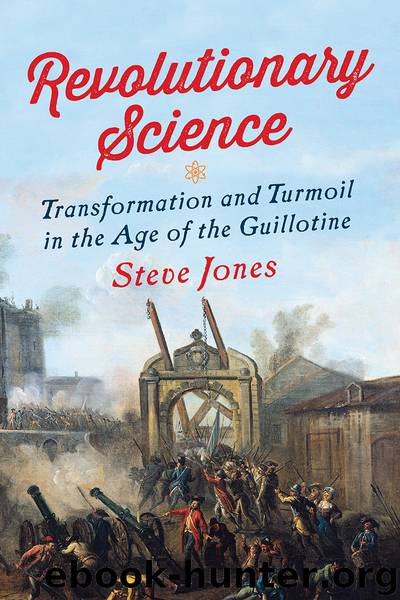Revolutionary Science by Steve Jones

Author:Steve Jones
Language: eng
Format: epub
Publisher: Pegasus Books
Published: 2017-02-08T05:00:00+00:00
CHAPTER VI
THE EMPIRE OF ANARCHY
. . . instead of a green flowery world, there is a waste wild-weltering chaos: which has again, with tumult and struggle, to make itself into a world.
THOMAS CARLYLE, The French Revolution
Pierre-Simon Laplace, logician to the universe
The Eiffel Tower was erected, against much opposition, as a temporary entrance for the World’s Fair of 1889, itself organised to mark the triumphs of France in the century since the Revolution (one of several other proposals was to build a three hundred-metre tall model of a guillotine, but that did not find favour).
La Tour rises from the Champ de Mars, which played a large part in that era as the launch pad of the world’s first hydrogen balloon, the location of the first Bastille Day celebration, and the altar of celebration for Robespierre’s Cult of the Supreme Being. In 1791, the open space was for a time renamed the Field of Blood, after the massacre of dozens of protesters by order of the mayor of Paris.
The structure itself was at first derided as a blot on the face of the City of Light. The author Guy de Maupassant often, or so he claimed, ate lunch in the restaurant at its base, on the grounds that it was the one place where he could be guaranteed not to see it. A petition signed by many other grand figures in the arts was florid in its condemnation: ‘the grotesque, mercenary invention of a machine builder . . . the deflowering of Paris’. The Church, too, was outraged: the tower dwarfed every ecclesiastical edifice in the city and was ‘an insult to the Eternal’. Others returned to the logic of Franklin’s day to argue that it would attract thunderbolts and endanger the whole city.
The poet François Coppée made his anger public in three dozen verses of doggerel (J’ai visité la Tour énorme, / Le mât de fer aux durs agrès. / Inachevé, confus, difforme,/Le monstre est hideux, vu de près. / Géante, sans beauté ni style, / C’est bien l’idole de metal,/Symbole de force inutile/ Et triomphe de fait brutal . . .). Incomplete, confused, deformed, hideous, useless and free of style as the metallic idol might be, Coppée was in one way correct, for the three-hundred-metre mast is indeed, as a monument to science, a triumph of brutal fact. The seventy-two names of the great and good inscribed on its beams include biologists, astronomers, physicists, chemists, geographers and more. All share not just their talents but an attribute once universal among their profession, for every one among them is male (Sophie Germain, the self-taught female mathematician who was just thirteen when the old regime collapsed and whose work on the elasticity of metals was essential to the tower’s design, does not get a mention).
Paris’s ithyphallic tribute to the talents of the Y chromosome is reflected in another erection a few kilometres to the east. The Pantheon holds seventy-seven sets of illustrious remains, among them the bones of a dozen or so researchers (Foucault, who made the place famous, did not pass the entrance examination).
Download
This site does not store any files on its server. We only index and link to content provided by other sites. Please contact the content providers to delete copyright contents if any and email us, we'll remove relevant links or contents immediately.
Enlightenment Now: The Case for Reason, Science, Humanism, and Progress by Steven Pinker(7234)
A Journey Through Charms and Defence Against the Dark Arts (Harry Potter: A Journey Through…) by Pottermore Publishing(4781)
The Immortal Life of Henrietta Lacks by Rebecca Skloot(4525)
A Journey Through Divination and Astronomy by Publishing Pottermore(4344)
Elon Musk by Ashlee Vance(4030)
Origin Story: A Big History of Everything by David Christian(3648)
COSMOS by Carl Sagan(3554)
Alchemy and Alchemists by C. J. S. Thompson(3450)
Bad Pharma by Ben Goldacre(3356)
Enlightenment Now by Steven Pinker(3338)
Shadow of Night by Deborah Harkness(3302)
Inferior by Angela Saini(3276)
A Mind For Numbers: How to Excel at Math and Science (Even If You Flunked Algebra) by Barbara Oakley(3219)
Origin Story by David Christian(3147)
The Code Book by Simon Singh(3074)
Signature in the Cell: DNA and the Evidence for Intelligent Design by Stephen C. Meyer(3071)
The Elements by Theodore Gray(2998)
A Brief History of Time by Stephen Hawking(2961)
A Journey Through Potions and Herbology (A Journey Through…) by Pottermore Publishing(2828)
